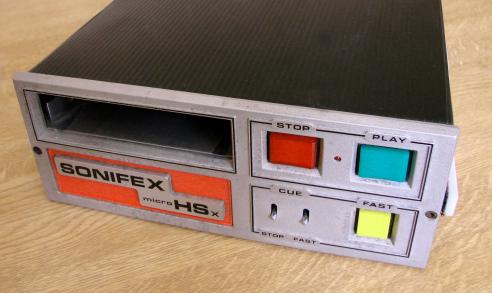All 8 -Track Cartridges can be converted to digital files of your choice 
Most widely used were the domestic 8-track stereo type that ran at a speed of 3.75 ips. There were also the industry standard broadcast studio NAB cartridges, these were mainly used in radio studios for instant start advertising and station jingles - the machines operated at a professional 7.5 ips speed offering extremely good quality stereo output. The endless loop tape cartridge was first designed in 1952 by Bernard Cousino around a single reel carrying a continuous loop of standard 1/4-inch, plastic, oxide-coated recording tape running at 3.75 in.(9.5 cm) per second. Program starts and stops were signaled by a one-inch-long metal foil that activates the track-change sensor.
(Bill Lear had tried to create an endless-loop wire recorder in the 1940s, but gave up in 1946, even though endless-loop 8 mm film cartridges were already in use for him to copy from. He would be inspired by Earl Muntz's four-track design in the early 1960s.)
Inventor George Eash, also from Toledo, invented a cartridge design in 1954, called the Fidelipac. The Eash cartridge was later licensed by manufacturers, notably the Collins Radio Corporation, which first introduced a cartridge system for broadcasting at the National Association of Broadcasters 1959 annual show. Fidelipac cartridges (nicknamed "carts" by DJs and radio engineers) were used by many radio stations for commercials, jingles, and other short items right up until the late 1990s when digital media took over. Eash later formed Fidelipac Corporation to manufacture and market tapes and recorders, as did several others, including Audio-Pak (Audio Devices Corp.). There were several attempts to sell music systems for cars, beginning with the Chrysler "Hiway hi-fi" of the late 1950s (which used discs). Entrepreneur Earl "Madman" Muntz of Los Angeles, California, however, saw a potential in these "broadcast carts" for an automobile music system. In 1962 he introduced his Stereo-Pak four-track cartridge stereo system (two programs, each consisting of two tracks) and tapes, mostly in California and Florida. He licensed popular music albums from the major record companies and duplicated them on these four-track cartridges, or "CARTridges", as they were first advertised. |
|
|
|
Transfer - Copy - Convert LP to CD | Vinyl to CD | 78 to CD | Tape to CD | Cassette to CD | DAT to CD |




































